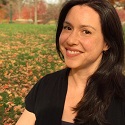Taylor Bryant
Dual BA/BFA Student
Telecommunications/Fine Arts
Project: Odd See'd
Odd See'd is an arts and technology project. Conceptually, the artwork captures the dynamic of sharing a new idea and fostering its growth. This project will transpose a digital image by Professor M. Dolinsky into a multi-dimensional form. The imagery will be augmented through the use of computer technologies by introducing modalities such as time, interaction and live manipulation of video. The plan will fuse knowledge of lighting and particle systems into a static image to create an engaging three dimensional world. Some of the technical challenges include creating a unique workflow that combines disparate software, media arts and new media technologies. The resultant artwork will be exhibited in a public display.
Kalani Craig
PhD Student
History
Project: Text Processing on Five Medieval Latin “Deeds of Bishops”
My current project focuses on five medieval Latin gesta episcoporum ("deeds of bishops") produced in five cities in Western Europe between the late sixth century and the mid-twelfth century. I am doing word usage studies, n-gram comparisons and other text processing tasks to determine these texts' relationship to each other and to the fifth-century Liber Pontificalis, a catalog of the early lives of the Roman bishops. To do so, I have written a custom program that accommodates synonyms and Latin's lack of dependency on word order, imported each of the three texts currently available in electronic form into a database, and then error-checked each word in post-processing. Portions of the project have already contributed to a published article and to my dissertation. In the shorter term, my hope is to find and process the other two remaining texts. My longer-term career goal is to refine a Latin-stemming and synonym-processing tool so that it takes into account the many variations in medieval Latin without requiring manual processing.
Mike Lee
PhD student
Ethnomusicology
Project: Church Creatives: Religious Media Production within Church Ritual
Michael's innovative project straddles the boundaries of folklore, music, and religious studies through a study of “church creatives”—paid and unpaid specialists who serve churches through sound and media design during worship. This is both a unique project and a sorely needed one: the audio-visual portion of the religious service plays a crucial role in congregants’ prayer experiences, yet the people who facilitate it have never been the subject of extended scholarly inquiry. Through skillful integration of extensive online ethnographic fieldwork and fieldwork at church sound conventions and other physical sites where church creatives congregate, Mike will offer a fresh and intimate analysis of religious media production within church ritual. To me, Mike is perfectly situated to turn this research into a major study on the relationship of technology with Christian sound and feeling, as seen from the perspective of the people who mediate between congregants, church leadership, personal belief, and communal perceptions of the divine.
Scott Weingart
PhD Student
School of Information and Library Science
Project: Changing communication in scholarly networks
"Changing communication in scholarly networks" is a project which uses both quantitative and qualitative methods to understand the effects of large scale changes in communication structures to the everyday practices of scholarship. Scholars have been communicating for a long time; scholarship is, after all, a largely (and just plain large) social phenomenon. The method and medium of that communication has changed drastically over the last thousand years -- several times, and usually in such far-reaching ways as to earn the retroactive title of "revolution." These communicative changes bring with them certain baggage. Perhaps early adopters are initially more interdisciplinary because they work with those they previously had no reason to, or perhaps scholars begin writing and fretting on how they'll manage all this information now that it comes so quickly and in such mass. It is the purpose of this project to tease out the regular changes, if they exist, that occur with changes in scholarly communication both current and historical.





